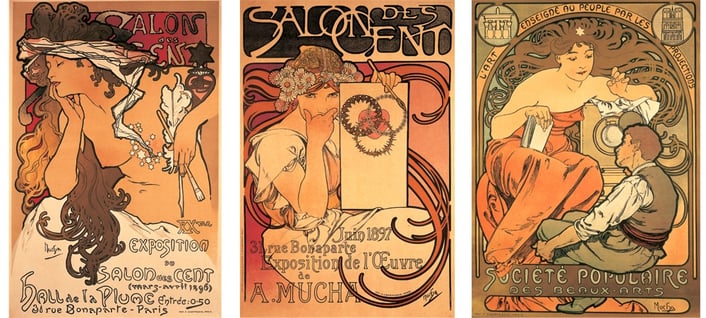At the turn of the nineteenth century, cultural hubs in Europe, such as the cities of Paris and Vienna, were experiencing growth in all aspects of the modern lifestyle. Art nouveau artwork effectively sold the glamour of this ‘fin de siècle’ atmosphere, the decadence of the bourgeois class and the changing social mores that were taking place. A key player in this was the Czech artist Alphonse Mucha, who lived and worked in Paris for nearly 20 years and produced a huge number of influential artworks in the realm of commercial illustration. His decorative, curvilinear designs featured on not only posters but on a range of other products, earning him enormous success at the centre of the art world in Paris.

La belle époque
Along with other leading art nouveau poster designers of the time – such as Jules Chéret, Toulouse-Lautrec, Paul Berthon, Théophile Steinlen, Georges de Feure, Eugène Grasset, and many others – Mucha and his work rose to prominence in response to the growth of consumer culture. The creation of modern conveniences in the home and new technologies for transport and entertainment paved the way for this consumer demand. Development of printing technology and the rise, also, of magazines, helped disseminate ideas and images to larger audiences. Advertisements became an art form, a way for artists to demonstrate their skills and produce illustrations that would be seen by many people, whether that be in posters for theatres, exhibitions, cafes and publications, or adverts for specific products and services. There was a desire among advertisers for their products to be linked with artwork that captured the excitement of the new, and the joie de vivre aspect of the Parisian lifestyle. Mucha’s ethereal motifs embodied that very essence, and, bridging the gap between ‘high art’ and commercialism, were able to lend beauty to a product and turn everyday objects into works of art.
Mucha praised the 1900 'Exposition Universelle' (where the art nouveau style was predominant) for ‘bringing aesthetic values into arts and crafts’. With its origins from the British Arts and Crafts movement, as well as the influence of Japanese woodblock art, the art nouveau style dominated this period and was epitomized by Mucha’s iconic posters. His first major contract cemented his work at the forefront of commercial art: he illustrated a poster for the famous actress Sarah Bernhardt, who was delighted with the result and signed him on for a number of years. Mucha went on from designing her posters and stage sets, as well as some of her jewellery and costumes too, to producing designs for the jewellery boutique for Georges Fouquet. By 1981 he was able to live off his commercial art, with his designs effectively becoming a form of Gesamtkunstwerk or ‘total work of art’, coming in a range of mediums including book illustrations, calendars, screens and decorative wall panels (such as his beautiful Season series).
Creating a Brand
The power of the Art Nouveau posters of this period lay in their ability to communicate: the images were arresting, often using stark contrasts and flat blocks of colour (again drawing influence from Japanese prints), and when advertising products they were economical with the amount of text so that the image could speak mostly for itself. The posters were designed to sell products by depicting the sort of idealized lifestyle that was offered by the use or ownership of such things. The style and atmosphere of the posters was everything; the product itself had very little to do with it. This allowed an identifiable aura to develop around a great range of products, linked by the same associated style to the extent that consumers were buying into a lifestyle as opposed to buying any one isolated product. In this way, the modern lifestyle fed the adverts, which in turn fed the lifestyle.
Transferring the image and style of the advertising posters to the product itself kept up this communication of ideals – the same image would be recreated on the product’s packaging, strengthening the association between product and advert, as in the case of Mucha’s images gracing Lefèvre-Utile biscuit tins. Mucha was also famously commissioned to create posters for JOB cigarette rolling papers, with the result that the JOB brand became immediately identifiable through its advertising and packaging. As well his use of natural motifs, Mucha’s sensuous female figures were well-recognized, and their appearance on a product or poster became not only an instant indicator of the product’s quality, but also the sort of lifestyle associated with it, and the other kinds of products associated with that ideal. The women in his designs were an intoxicating mix of goddess, virgin and temptress, stylized females with ‘macaroni’-like long hair and dressed in neo-classical attire. Their relevance to the product was only in terms of the associated glamour, so that the same style of designs was able to sell diverse consumer products like perfume, chocolate drinks, absinthe and train travel alike.
If you’d like to see more of Mucha’s stunning posters capturing the spirit of the era, look no further than our very own book Alphonse Mucha: Masterworks. It can be bought from our website here, or via Amazon here.
LINKS
- Read more about Le Style Mucha here.
- Take a look at advert posters for JOB cigarettes adverts through the years.
- Many aspects of the fashion of the period can be observed from what has been chosen to clothe the figures in advertising posters. Have a read about the history of fashion in this era here.




